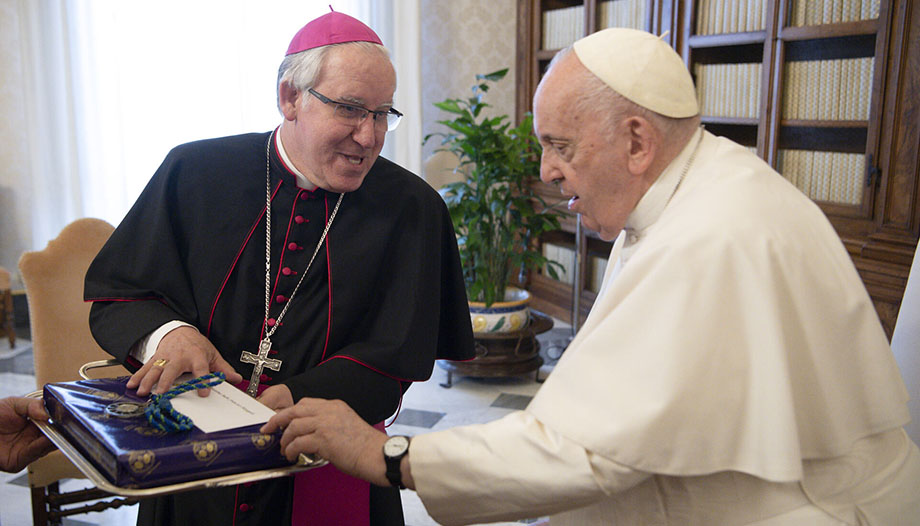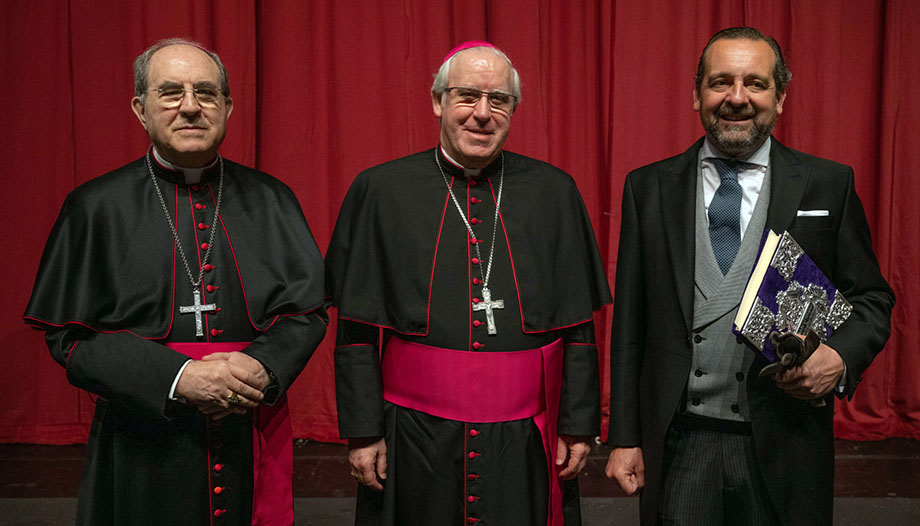– Supernatural Twitter account of the Archbishop of Seville, Jose Angel Saiz Meneses (Sisante (Cuenca) August 2, 1956) reported a fact: last August 12, the Auxiliary Bishop of Sydney, Mons. Richard Umbers and a team from his diocese visited Seville for several days to learn, in the field, about the Brotherhoods and Confraternities. In addition to being amusing, the anecdote is revealing: popular piety is, at present, the main brake on secularization in Western nations.
This year also marked the thirtieth anniversary of the visit of theSt. John Paul II to the village of El Rocío. There, in the heart of one of the most beloved popular devotions in Spain, the Holy Father encouraged Catholics to delve into "the foundations of this devotion, to be able to give these roots of faith their evangelical fullness; that is, to discover the profound reasons for the presence of Mary in your lives as a model in the pilgrimage of faith.
Recalling this event and with a view to the undeniable strength of popular piety, the bishops of the dioceses of southern Spain published the Pastoral Letter "Mary, Star of Evangelization. The evangelizing power of popular piety."in which they affirm how popular piety "gathers the best of each culture and converts it into a living expression of faith".
In this interview with Omnes, Bishop Saiz MenesesThe president of the Pontifical Council for the Laity, who is already preparing the congress on popular piety, emphasizes how the "Brotherhoods are a transversal reality, like the Church itself" and popular piety is undoubtedly "a dike of containment of secularization".
You have been able to become immersed in the importance of popular piety in a diocese as outstanding in this aspect as Seville. Is it really a dike to contain secularization?
-I arrived at Seville two years ago. I come from Catalonia. In Tarrasa, I accompanied 24 "rocieras" brotherhoods that could not go to the Rocío and celebrated their pilgrimage there, with much affection. That was like a little plant of popular piety. Here in Seville it is a whole forest. In this diocese we have Sisterhoods with thousands of brothers, some with more than 16,000. In these years, I have not seen a single case of suppression of any brotherhood; on the other hand, there are continual requests for new brotherhoods. Therefore, it is a growing phenomenon.
I have been able to verify that the southern half of Spain is less secularized than the northern half and this, in good part, is due to this world of the Brotherhoods and Confraternities. Why? Because the transmission of the faith, which is something so important in the life and pastoral work of the Church, continues to be done in a natural way in the Brotherhoods.
When talking about this natural wayWhat are you referring to specifically?
-Faith is transmitted in the Sisterhoods as if by osmosis. It is lived. During Holy Week, I usually take the opportunity to go to the exit of the processions that I can, especially in neighborhood parishes. It attracts my attention to see mothers dressed as Nazarenes, with children in their arms, who are not walking, also dressed as Nazarenes, and that child, when he starts to walk, will go with his mother accompanying the Virgin or Christ.

Last June, I traveled with the executive committee of the II International Congress of Sisterhoods and Popular Piety to see Pope Francis and I remembered this example. The Pope commented that mothers use a "maternal dialect" to transmit the faith, that they are the ones who speak to their young children of the Virgin, of Jesus... that they carry them along with them, in their arms to this faith.
This is lived, naturally, in the Brotherhoods and explains this brake on secularization.
There are those who, even today, pigeonhole popular piety as a mere display of "sentimentality"?
-In two boxes: that of sentimentalism and that of low culture. Years ago, above all, it seemed that popular piety was typical of people with little culture. That it belonged to people with little education who "could not aspire to more". This is not so.
I receive many governing boards of fraternities that come to present their actions and projects and I meet businessmen, company directors, many professors and university professors. Along with them, self-employed, workers, employees... The Brotherhoods are a transversal reality, like the Church itself.
Popular piety is not for illiterate people, it is a way of encountering God: the via pulchritudinis which is not only perfectly valid for the encounter with God, but is complementary to a more speculative way. There are many very educated, very cultured people, for whom this way is the one that most helps them to encounter God.
Do you think that progress is being made in the area of formation in the confraternities?
-The Brotherhoods are governed by rules in which there are three pillars: worship, formation and charity.
The cults are solemn celebrations, which are very well done.
Formation, indeed, is the area that costs the most, but as it costs priests and bishops the ongoing formation. Many times we have so many pastoral urgencies that prayer is hardly enough, let alone in the case of lay men and women, fathers and mothers of families....
Finally, charity. The brotherhoods have an impressive social and charitable work, so what more can we ask for?
How is the manifestation of faith, personal commitment, promoted in this area?
-In addition to the three dimensions already known, we are gradually seeing a fourth dimension gaining importance in the lives of women and men. Sisterhoodsmission awareness and evangelization.
In November 2021, shortly after my arrival in Seville, the mission of the Gran Poder took place. The statue visited the poorest neighborhoods of the city, it was in each of the parishes. I attended everything I could, especially the transfers. That was impressive: the faces, the looks on the faces of the children, the young people, the elderly, the sick?
The carving of Nuestro Padre Jesús del Gran Poder has, in itself, a great aesthetic beauty and, above all, a spiritual and religious strength that could be felt just by passing by. "The Lord of Seville who comes to see me", people said... That was something very great.
Now other brotherhoods are carrying out these missions. This dimension is being strengthened, because the human being is sensitivity, feeling, heart; is reason, understanding; and is faith and spirituality. The three levels are necessary and complementary, not exclusive. So why exclude this level that helps people so much? It is a pastoral task that is gaining strength.
How does popular piety fit into parish, community and daily life?
-When I explain the Archdiocese of Seville to people who do not know it, I point out to them: 264 parishes, most of them very active throughout the diocese, 125 communities of active life, 34 monasteries and convents of contemplative life. Together with them, all the ecclesial realities: Opus Dei, Neocatechumenal Way, Cursillos de Cristiandad, Focolarinos, the Work of the Church, Catholic Action..., etc., etc. All with great presence and vitality. And together with them, 700 brotherhoods.
Faced with this reality, the first thing to do is not to fall into complacency and, above all, what we must do is to grow in ecclesial communion and synodality. Thus, united, the pastoral and evangelizing effect will multiply.
In the case of the Brotherhoods, for example, their spiritual directors are usually pastors of the village churches, they are united to many parishes and, therefore, they are united to this parish life. For example, the catechetical itineraries are done in the parishes, they are not duplicated.
The bishops of the South have published an interesting pastoral letter on popular piety. How can we prevent it from being forgotten?
-Certainly, with all official documents there is a danger that they go from the printing press to the bookshelf. In Seville, in preparation for the II International Congress of Brotherhoods and Popular Piety in December 2024, the ongoing formation of the Brotherhoods will deal, this year, with this letter. I myself always give a conference to the older brothers at the beginning of the course and we will talk about this letter.

How has the Pope welcomed this II International Congress of Brotherhoods and Popular Piety?
-Last June, I presented the congress to the Pope. He spoke to us about the importance of evangelizing culture and inculturating the faith. He stressed the importance of popular piety as that personal, familiar, close piety that is transmitted in the home, through the mother's dialect.
He urged us to strengthen this area, to accompany him and to be very welcoming. In addition, the Pope asked us to take care of the "faith of the simple" and of everyone. He advised us to give content and formation to all this area and to strengthen this evangelizing dimension.
He also insisted on coherence of life, that we help all the faithful to live a coherent social, professional and ecclesial life.








